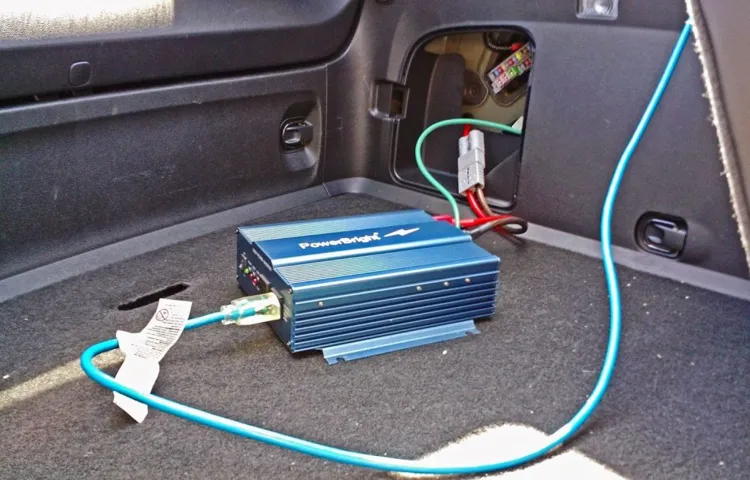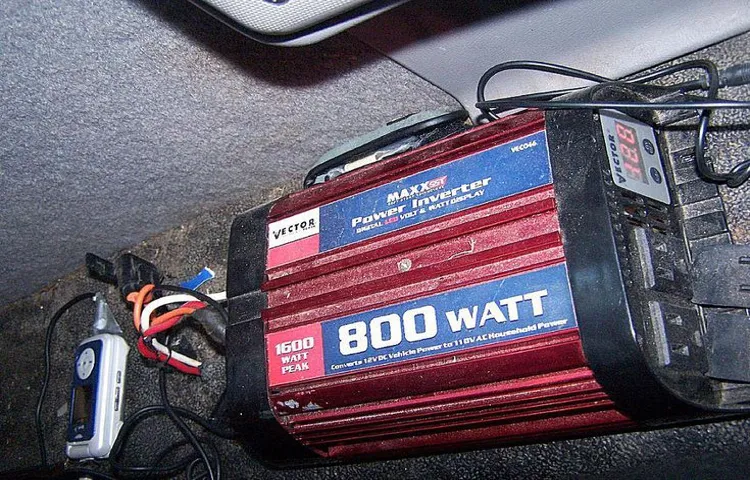Hey there! Have you ever wondered how you can power your devices and appliances when you’re off the grid or experiencing a power outage? Well, that’s where power inverters come in! They’re like the superheroes of electricity, converting DC power from batteries or solar panels into AC power that can be used to run all your favorite electronics. Think of a power inverter as a translator that helps your devices communicate with different power sources. It takes the direct current (DC) electricity produced by your batteries or solar panels and converts it into alternating current (AC) electricity that can be used to power your TV, refrigerator, or even charge your laptop.
It’s like turning a hand crank into a smooth, continuous motion. What’s even cooler is that power inverters come in all shapes and sizes, so you can find one that suits your needs. Whether you’re looking for a portable inverter to keep your phone charged on a camping trip, or a larger inverter to power your entire home during an outage, there’s one out there for you.
So, if you’re tired of being held hostage by the grid, or you just want to be prepared for any power-related emergencies, it might be time to invest in a power inverter. Say goodbye to blackouts and hello to uninterrupted power supply! Get ready to take charge of your electricity with the help of these incredible devices. Stay tuned for more information on how power inverters work, the different types available, and how to choose the right one for your needs.
Let’s power up together!
Table of Contents
What is a Power Inverter?
Have you ever found yourself in a situation where you needed to plug in an electronic device while on the road? Maybe you wanted to charge your phone or use a laptop while traveling. Well, the good news is that installing a power inverter in your car can solve this problem by allowing you to convert the DC power from your car’s battery into AC power that can be used to power household devices. So, how do you go about installing a power inverter in your car? First, you’ll need to choose the right power inverter for your needs.
Power inverters come in various sizes and power ratings, so you’ll want to select one that can handle the amount of power you plan on using. Once you’ve chosen the right inverter, you’ll need to find a suitable location to mount it. This could be under your car’s dashboard or in the trunk, as long as it’s in a well-ventilated area and secure.
Next, you’ll need to connect the power inverter to your car’s battery. This typically involves connecting the red wire from the inverter to the positive terminal of the battery and the black wire to the negative terminal. It’s important to make sure the connections are secure and properly insulated to prevent any electrical issues.
After the inverter is connected to the battery, you’ll need to connect it to your car’s electrical system. This involves connecting the inverter’s output wiring to a suitable electrical outlet in your car. This could be a cigarette lighter socket or a dedicated power outlet if your car has one.
Again, it’s important to make sure the connections are secure and properly insulated to prevent any electrical issues. Once everything is connected, you’ll need to test the power inverter to make sure it’s working properly. Start by turning on your car’s engine and then plugging in a device into the electrical outlet.
If everything is connected correctly, the device should power on without any issues. Installing a power inverter in your car can greatly expand your ability to use electronic devices while on the road. Whether you need to charge your phone, power a laptop, or even run small appliances, a power inverter can provide the AC power you need.
Definition and Functionality
power inverter

Types of Power Inverters
power inverters, types of power inverters, what is a power inverter, power inverter definition
Choosing the Right Power Inverter for Your Car
Installing a power inverter in your car can be a great way to turn your vehicle into a mobile power source. Whether you need a power outlet to charge your electronics on the go or you want to run small appliances while camping or tailgating, a power inverter can provide the necessary electrical current. When choosing the right power inverter for your car, it’s important to consider several factors.
The first thing you’ll need to determine is the wattage requirements of the devices you plan to power. This will help you determine the size of the inverter you’ll need. You’ll also need to consider the type of inverter you want, such as a modified sine wave inverter or a pure sine wave inverter.
Modified sine wave inverters are less expensive but may not be suitable for sensitive electronics, while pure sine wave inverters provide a cleaner and more stable power output. Additionally, you’ll want to ensure that the inverter you choose is compatible with your car’s electrical system and that it has the necessary safety features, such as overload and short-circuit protection. By considering these factors and choosing the right power inverter, you can enjoy the convenience of powering your devices and appliances on the go.
Determining Your Power Needs
power inverter for car
Considerations for Car Compatibility
car compatibility, power inverter, choosing the right power inverter for your car Have you ever been on a road trip and wished you could charge your laptop or use your phone charger in your car? Well, with the right power inverter, you can do just that! But choosing the right power inverter for your car requires a few considerations. One important factor is car compatibility. Not all power inverters are suitable for every car.
Some cars have limited electrical capacity and may not be able to handle the load of a power inverter. It’s essential to know your car’s electrical capacity and choose a power inverter that is compatible with it. Additionally, the type of power inverter you choose should match the outlets in your car.
Some cars have AC outlets, while others only have DC outlets. Make sure the power inverter you choose has the appropriate outlets for your car. By considering car compatibility, you can ensure that your power inverter works seamlessly with your car and provides you with the convenience you need on the road.
Researching and Comparing Inverters
power inverter, car, choose, research, compare, right
Preparing Your Car for Inverter Installation
So, you’ve decided that you want to install a power inverter in your car to provide electricity for all your devices while you’re on the go. That’s a great idea! But before you dive into the installation process, it’s important to make sure your car is prepared for the task. Firstly, you’ll need to identify the specific power requirements of the inverter you plan to install.
This includes knowing the wattage and voltage requirements of the devices you plan to power with the inverter. Once you have this information, you can determine the size and capacity of the inverter you’ll need. Next, you’ll want to ensure that your car’s battery can handle the additional load that the inverter will put on it.
This is especially important if you plan to use the inverter for extended periods of time or for high-power devices. It might be necessary to upgrade your battery or make other modifications to your car’s electrical system to accommodate the inverter. Another consideration is where you’ll be installing the inverter in your car.
You’ll want to choose a location that is easily accessible, but also safe and secure. Remember that the inverter will generate heat when it’s in use, so make sure it’s installed in a well-ventilated area to prevent overheating. Lastly, it’s a good idea to consult the owner’s manual or a professional for guidance on the specific installation process for your car.
Every car is different, so there may be unique considerations or steps that apply to your vehicle. By taking these steps and preparing your car properly, you’ll be well on your way to enjoying the convenience and power of a power inverter in your car. So, get ready to hit the road and stay powered up wherever you go!
Gathering Necessary Tools and Materials
Installing an inverter in your car can greatly enhance its functionality and convenience, allowing you to power various electronic devices on the go. But before you get started, it’s important to gather all the necessary tools and materials. First and foremost, you’ll need to purchase an inverter that suits your power needs.
Consider factors such as wattage and voltage compatibility with your car’s electrical system. Additionally, you’ll need a set of basic hand tools, such as screwdrivers and wire cutters, to assist with the installation process. It’s also a good idea to have electrical tape and wire connectors on hand to ensure secure connections.
Finally, make sure to have a reliable source of power, such as a battery charger, as you may need to disconnect the car’s battery during the installation. By preparing all these tools and materials beforehand, you’ll be well-equipped to successfully install an inverter in your car.
Preparing the Car Battery
car battery, inverter installation
Identifying a Suitable Location
When it comes to installing an inverter in your car, one of the first things to consider is identifying a suitable location for it. This is crucial because the inverter needs to be placed in a spot where it won’t interfere with your driving or cause any safety hazards. One popular location is underneath the dashboard, as it is easily accessible and doesn’t take up much space.
Another option is to mount it in the trunk, as long as there is enough ventilation to prevent overheating. Additionally, you’ll want to make sure the location you choose has easy access to the car’s battery, as the inverter will need to be connected to it. By taking the time to properly prepare your car and choose the right location, you’ll ensure a smooth and efficient installation process.
Installing the Power Inverter
Installing a power inverter in your car can be a great way to have access to AC power while on the go. Whether you want to charge your laptop, run a small appliance, or use other electronic devices in your vehicle, a power inverter can provide the necessary power. To install a power inverter, start by choosing the right size and type of inverter for your needs.
Then, locate a suitable location in your car to mount the inverter. It’s important to select a location that is well-ventilated, as inverters produce heat during operation. Next, connect the inverter to your car’s battery using appropriately sized cables.
Make sure to connect the positive cable to the positive terminal of the battery and the negative cable to the negative terminal. Finally, mount the inverter in its chosen location and secure it properly. Once everything is securely in place, you can start using your power inverter to power your electronics in the car.
With a power inverter installed, you can enjoy the convenience of AC power wherever you go.
Mounting the Inverter
Installing the Power Inverter
Connecting the Inverter to the Battery
power inverter, connecting, installing, battery
Securing and Protecting the Wiring
In the previous blog section, we discussed the importance of securing and protecting the wiring when installing a power inverter. Now let’s dive deeper into the process of actually installing the power inverter. First and foremost, it’s crucial to choose a suitable location for the power inverter.
You want to ensure that it is easily accessible for maintenance or repairs, but also well-protected from potential damage or tampering. Ideally, the power inverter should be installed in a clean, dry, and well-ventilated area. Next, you’ll need to connect the power inverter to your vehicle’s battery.
This typically involves running a positive (red) and negative (black) wire from the power inverter to the corresponding terminals on the battery. It’s important to make sure that these connections are secure and tight to avoid any electrical issues or malfunctions. Once the power inverter is connected to the battery, you’ll need to connect it to the electrical system of your vehicle.
This can usually be done by tapping into an existing power source, such as the fuse box or cigarette lighter. However, it’s important to ensure that the power source you choose can handle the electrical load of the power inverter. If not, you may need to install a separate circuit or fuse to protect the power inverter and prevent any potential damage.
After making all the necessary connections, it’s crucial to test the power inverter before using it. This involves turning on the vehicle’s engine and checking if the power inverter is functioning properly. You can do this by plugging in a small electronic device, such as a phone charger, and making sure it receives power.
In conclusion, installing a power inverter requires careful consideration of its location, proper wiring connections, and thorough testing. By following these steps, you can ensure the safe and effective operation of your power inverter, providing you with reliable power for all your electrical needs on the go. So go ahead and get started on your power inverter installation project and enjoy the convenience it brings to your vehicle!
Testing and Troubleshooting
Installing a power inverter in a car is a great way to have access to AC power while on the go. Whether you need to charge your laptop, power a small appliance, or use other electronic devices, a power inverter can be a handy tool. The installation process is not overly complicated, but it does require some basic knowledge of car electrical systems.
To start, you’ll need to choose the right power inverter for your needs. Consider what devices you plan to power and their wattage requirements. It’s important to select an inverter that can handle the total power load without overloading your car’s electrical system.
Once you have the right power inverter, you’ll need to find a suitable location to mount it. Look for a spot that is easily accessible and can accommodate the size of the inverter. It’s also important to ensure that there is enough ventilation to prevent the inverter from overheating.
Next, you’ll need to connect the inverter to your car’s battery. This is usually done by connecting the positive wire to the positive battery terminal and the negative wire to the negative terminal. It’s essential to make sure the connections are secure and there are no loose wires that could cause a short circuit.
After the inverter is connected to the battery, you can test it to make sure it’s working properly. Start by turning on your car’s engine and then plugging in a device to the inverter’s AC outlets. If everything is connected correctly, the device should power on without any issues.
If you encounter any problems or the inverter isn’t working as expected, it’s important to troubleshoot the issue. Start by double-checking all the connections to ensure they are secure. You may also need to check the fuse for the inverter and replace it if it’s blown.
Checking Connection and Power Output
When it comes to troubleshooting and testing your devices, one of the first steps you should take is checking the connection and power output. This is important because a weak or faulty connection can prevent your device from functioning properly, and a low power output can result in issues such as slow performance or even a complete shutdown. So, how can you check these two crucial factors? First, make sure all the cables and connectors are securely plugged in.
Sometimes, a loose connection can be the culprit behind a malfunctioning device. Next, check the power source and make sure it’s providing enough power to meet the requirements of your device. If you’re using a power adapter, ensure it’s working correctly by trying it with another device or replacing it if necessary.
By testing and troubleshooting the connection and power output, you can quickly identify and resolve any issues to get your device up and running smoothly. So, don’t hesitate to take a closer look at these factors the next time your device is acting up.
Troubleshooting Common Issues
Testing and troubleshooting are essential processes in identifying and resolving common issues that may arise in various areas such as technology, appliances, or even everyday tasks. When it comes to testing, it involves carrying out experiments or assessments to evaluate the performance or functionality of a particular product, system, or process. This can be done through various methods such as conducting tests, simulations, or analyzing data.
On the other hand, troubleshooting is the process of identifying and resolving problems or malfunctions that occur during the normal operation of a product or system. It requires a systematic approach that includes gathering information, analyzing symptoms, and applying logical reasoning to find the root cause of the issue. By understanding the importance of testing and troubleshooting, individuals can effectively address and solve common problems, ensuring smooth operations and optimal performance.
Conclusion
So there you have it, folks! We’ve successfully navigated the intricate process of installing a power inverter in your car. Now you’ll be able to transform your vehicle into a mobile power station, catering to all your energy needs on the go. Whether you’re road tripping and want to keep your gadgets charged, or find yourself in need of a power source during an emergency, this little contraption will always have your back.
Now, installing a power inverter might sound daunting at first, but with a little patience and some elbow grease, you can conquer this task. Just remember to gather all the necessary tools and materials, locate a suitable spot for the inverter, properly connect the wires, and always prioritize safety. Now, why would you go through the trouble of installing a power inverter in your car, you might ask? Well, we live in an age where power has become an essential part of our lives, and being equipped with a mobile power source opens up a whole new world of possibilities.
Maybe you want to impress your friends with a spontaneous tailgate party, or perhaps you’re a modern-day MacGyver ready to tackle any situation that comes your way. Having a power inverter in your car can also prove to be a real game-changer during an apocalypse, should one ever occur. While others are scrambling for survival, you’ll be comfortably charging your phone, powering your mini fridge, and even watching your favorite post-apocalyptic movies on a portable projector.
In all seriousness though, a power inverter is a practical addition to any vehicle, be it for work or leisure. It gives you the flexibility to power your devices and appliances wherever you are, without having to rely on traditional power outlets. Whether you’re a road warrior or just someone who enjoys the convenience of portable power, installing a power inverter in your car will undoubtedly enhance your on-the-go experience.
So, grab your screwdriver, unleash your inner handyman, and get ready to revolutionize your vehicular power game. With the right tools and a little know-how, you’ll be feeling like the MacGyver of the road in no time. Just remember, with great power comes great responsibility, so use your newfound power wisely, my friends.
Happy converting!”
Final Tips and Considerations
When it comes to testing and troubleshooting your website, there are a few important considerations to keep in mind. First, it’s crucial to thoroughly test your site before launching it to the public. This means checking for any broken links, missing images, or other errors that could negatively impact the user experience.
Additionally, you should test your site across different devices and browsers to ensure that it looks and functions properly for all users. One useful tip is to have a clear plan in place for troubleshooting any issues that may arise. This could include creating a checklist of common problems and their solutions, or keeping a log of any errors or glitches that occur.
This will help you identify patterns and quickly address any issues that come up. Another consideration is the importance of regularly monitoring your website’s performance. This includes regularly checking important metrics such as page load times and bounce rates, as well as regularly performing security scans to ensure that your site is protected from potential threats.
Overall, testing and troubleshooting are essential steps in the website development process. By thoroughly testing your site and having a plan in place for troubleshooting, you can ensure that your website is running smoothly and providing an optimal user experience.
Enjoying the Benefits of a Power Inverter
power inverter, testing, troubleshooting
FAQs
What is a power inverter and how does it work?
A power inverter is a device that converts DC power from a car’s battery into AC power, allowing you to run household appliances and electronics. It works by changing the electrical current from one form to another.
Why would I need a power inverter in my car?
A power inverter can be useful for a variety of reasons, such as charging laptops or smartphones, running small appliances like a mini fridge or coffee maker, or even powering tools or camping equipment while on the go.
How do I choose the right power inverter for my car?
When choosing a power inverter, consider factors such as the wattage and voltage requirements of the devices you plan to use, the type and number of outlets needed, and whether you want a modified sine wave or pure sine wave inverter.
How do I install a power inverter in my car?
To install a power inverter, you will typically need to connect it directly to your car’s battery using the provided cables. It is important to follow the manufacturer’s instructions carefully and ensure proper grounding to avoid any electrical hazards.
Can I use a power inverter while driving?
Yes, you can use a power inverter while driving. However, it is important to secure the inverter in a stable location and avoid using it while the car is in motion to prevent any distractions or accidents.
Are power inverters safe to use in a car?
Power inverters can be safe to use in a car if installed and used properly. It is important to use the right gauge wiring, ensure proper ventilation for the inverter, and avoid overloading it with devices that exceed its power capacity.
Can I use a power inverter to charge my car battery?
No, a power inverter is designed to convert DC power to AC power and is not suitable for charging car batteries. To charge a car battery, you will need a battery charger specifically designed for that purpose.



